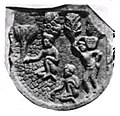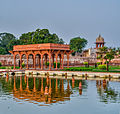The Gardening Portal

Gardening is the process of growing plants for their vegetables, fruits, flowers, herbs, and appearances within a designated space. Gardens fulfill a wide assortment of purposes, notably the production of aesthetically pleasing areas, medicines, cosmetics, dyes, foods, poisons, wildlife habitats, and saleable goods (see market gardening). People often partake in gardening for its therapeutic, health, educational, cultural, philosophical, environmental, and religious benefits. Gardening varies in scale from the 800 hectare Versailles gardens down to container gardens grown inside. Gardens take many forms, some only contain one type of plant while others involve a complex assortment of plants with no particular order. (Full article...)
Horticulture is the science and art of growing fruits, vegetables, flowers, or ornamental plants. Horticulture is commonly associated with the more professional and technical aspects of plant cultivation on a smaller and more controlled scale than agronomy. There are various divisions of horticulture because plants are grown for a variety of purposes. These divisions include, but are not limited to: propagation, arboriculture, landscaping, floriculture and turf maintenance. For each of these, there are various professions, aspects, tools used and associated challenges; Each requiring highly specialized skills and knowledge of the horticulturist. (Full article...)
General images -
Selected article -

The cottage garden is a distinct style that uses informal design, traditional materials, dense plantings, and a mixture of ornamental and edible plants. English in origin, it depends on grace and charm rather than grandeur and formal structure. Homely and functional gardens connected to cottages go back centuries, but their stylized reinvention occurred in 1870s England, as a reaction to the more structured, rigorously maintained estate gardens with their formal designs and mass plantings of greenhouse annuals.
The earliest cottage gardens were more practical than today's, with emphasis on vegetables and herbs, fruit trees, perhaps a beehive, and even livestock. Flowers, used to fill spaces, gradually became more dominant. The traditional cottage garden was usually enclosed, perhaps with a rose-bowered gateway. Flowers common to early cottage gardens included traditional florists' flowers such as primroses and violets, along with flowers with household use such as calendula and various herbs. Others were the richly scented old-fashioned roses that bloomed once a year, and simple flowers like daisies. In time, cottage-garden sections were added to some large estate gardens as well. (Full article...)
Selected image

Related portals
Did you know -
- ... that The Lord of the Ice Garden, a Polish novel series mixing elements of fantasy and science fiction, has been compared to The Witcher?
- ... that Nusrati attributes the virtues of a good ruler to his patron Ali Adil Shah II in The Rose Garden of Love?
- ... that Parimal Garden in Ahmedabad has scrap-metal monkeys?
- ... that Ardwall House has a garden ornament in the form of an early mediaeval Pictish slab inscribed with a Celtic cross?
- ... that controversy ensued when the painting Pleasure Garden was offered to the Robert McDougall Art Gallery?
- ... that a guerrilla garden established atop an abandoned railroad in Long Island City became legally recognized by the MTA?
- ... that Xu Garden was created by community residents grateful to their local warlord?
- ... that much of what we know of medieval gardens comes from illuminated manuscripts?
Things you can do
- This list is transcluded from the tasks list page. To edit the list, click here
 |
Here are some tasks awaiting attention:
|
WikiProjects
Topics
Categories
Associated Wikimedia
The following Wikimedia Foundation sister projects provide more on this subject:
-
Commons
Free media repository -
Wikibooks
Free textbooks and manuals -
Wikidata
Free knowledge base -
Wikinews
Free-content news -
Wikiquote
Collection of quotations -
Wikisource
Free-content library -
Wikiversity
Free learning tools -
Wiktionary
Dictionary and thesaurus































































































